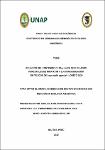Relación del contenido CD Pb y Hg en suelos agro forestales de Nina Rumi y su bioacumulación en tejidos de Inga edulis (guaba) - Loreto 2020
Abstract
Inga edulis "guaba" is a fabaceous plant species that grows and develops in the Amazon forest of the town of Nina Rumi. It is cultivated for its large edible pods, in addition to being used as shade in coffee plantations in South America, without However, little is known about the characteristics of the soil and the content of metals that the species concentrates in its various structures, the objective of this work was to determine the concentration of metals Cd, Pb and Hg both at soil level and of their floral constituents. The study was developed through the processes of drying, grinding and crushing official reagents, equipment and laboratory instruments were used, where atomic absorption spectrophotometry was used, which finally determined the high concentration of metals at soil level, reporting minimum values in the plant tissues, however, due to the Statistical reports show a higher concentration of Pb at the leaf level and Cd at the bark level. The values report the following results Cd mg / kg in leaf 0.012, Fruit 0.023, bark 0.043, the reports for lead Pb are, in Leaf 0.219, in fruit 0.085, in bark 0.143, finding a higher prevalence at the leaf level, as well as the concentration of Hg shows 0.020 in leaf, 0.011 in fruit and 0.013 in bark, with very close variations in both samples. High concentrations of metals are seen in soil with Hg 73%, Pb 96% and Cd 80%. Inga edulis “guaba” es una especie vegetal fabácea que crece y se desarrolla en la floresta amazónica del poblado de Nina rumi., se le cultiva por sus grandes vainas comestibles, además de ser utilizada como sombra en los cafetales a nivel de Sudamérica, sin embargo poco se conoce sobre las características del suelo y el contenido de metales que la especie concentra en sus diversos estructuras, el objetivo de este trabajo fue determinar la concentración de metales cadmio ,plomo y mercurio, tanto a nivel del suelo como de sus constituyentes florales. El estudio se desarrolló mediante los procesos de secado, molienda y trituración. Se utilizaron, reactivos oficiales, equipos e instrumentos de laboratorio, donde se utilizó la Espectrofotometría de Absorción atómica el mismo que determinó finalmente la alta concentración de metales a nivel del suelo, reportando valores mínimos en los tejidos de la planta, no obstante, por los reportes estadísticos se evidencia mayor concentración de plomo a nivel de hojas y cadmio a nivel de corteza. Los valores reportan los resultados siguientes cadmio mg/kg en hoja 0.012, Fruto 0.023, corteza 0.043, los reportes para plomo son, en Hoja 0.219, en fruto 0.085, en corteza 0.143, encontrando mayor prevalencia a nivel de hoja, asimismo la concentración de mercurio muestra en hoja 0.020, en fruto 0.011 y en corteza 0.013.con variaciones muy próximas en ambas muestras. Se aprecia altas concentraciones de metales en suelo con mercurio 73%, plomo 96% y cadmio 80%.
Collections
- Tesis [21]


